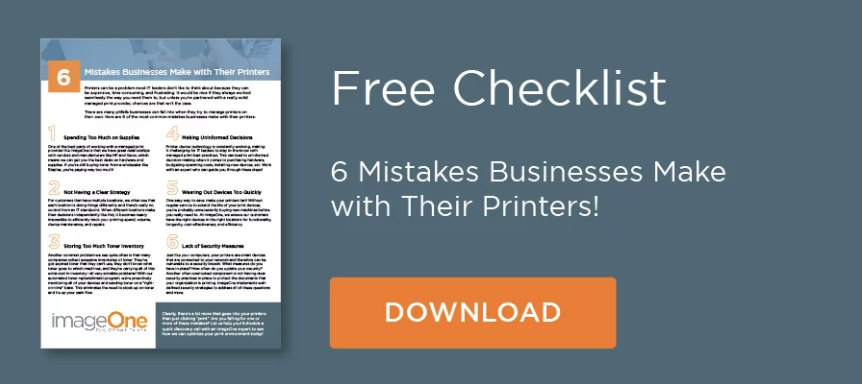In the managed print world, few numbers have more importance than the cost per page. In short, this tiny number—which often runs under a penny—will have a significant impact on the final price you’ll pay for an MPS service.
We’d never recommend signing any contract without fully understanding the service itself. So, if you’re interested in signing on with a managed print team, it’s essential to know how the cost per page, or CPP, works.
Why Do Costs Per Page Vary?
Before breaking down how the cost per page is determined, it’s critical to get why the CPP varies between clientele in the first place. As much as we’d love to say, “the cost per print for a medium-sized law office will cost X-amount of dollars,” any quick answer would be misleading.
That’s because many factors play a role in determining an organization’s cost per page. Since every business differs from the next—even within similar industries—managed print providers must individually evaluate every one separately. Then, they can determine the cost per page for the solutions that fit your needs.
Here are the most common reasons for these differences in cost:
- Age of Equipment: Simply put—the newer the equipment, the lower the CPP. As with most electronics, printers and copiers break down more frequently as they age. This makes it increasingly likely that our technicians will be making regular repairs on these older devices. The repairs themselves also take more time and effort to service, which increases service costs. Additionally, as printers and copiers age, the machine’s manufacturers produce fewer of their necessary parts—or even stop making them altogether. If one of these elusive parts needs replacement, it’s trickier and pricer to track them down.
- Printed Page Volume: Generally, the more pages a company prints, the lower the cost per page will be. A higher print volume helps the managed print service recuperate expenses.
In contrast, reduced print counts still require the MPS provider to offer exceptional service, pay for parts and toner, etc., while also receiving less consistent service contract revenue than the companies with larger print counts. In order to recoup these costs, prices are usually higher for companies with a smaller monthly page count.
- Color vs. Mono: Color printers and copiers cost more to maintain and run than mono (or black and white) devices. This is primarily because the managed print provider is now supplying four print toner cartridges; cyan, yellow, magenta, and black. Therefore, color printers will have a higher cost per page than mono devices.
- Level of Service: Any reputable MPS partner should be dedicated to providing incredible service, no matter the final, agreed-upon price. However, if a client desires more on-demand maintenance, an on-site technician, extra add-ons, etc., the cost per page (as well as the benefits you receive) will likely increase.
- Location: Costs will often decrease if you choose a local MPS vendor. As local vendors can send out their own employees—rather than recruit, hire, and send out a third-party technician—they can reduce their costs, which they can then pass down to the customer.
How is the Cost Per Page Calculated?
Now that we’ve identified why the cost per page fluctuates between different organizations, let’s dive into how an individual company’s final monthly base rate is established.
Most managed print service providers will define the final cost per page by calculating what’s called a blended rate. The blended rate is determined by the MPS provider looking at a company’s entire fleet and taking into account the variables mentioned above. After compiling this in-depth inventory, the MPS team will average the costs of each variable to create one mono and one color blended rate.
Next, your representative will take an inventory of how many pages your company prints monthly. Once this number is established, they’ll take about 75% of this monthly print count and multiply it by your blended cost per page for mono and color. This final calculation will yield your monthly base rates.
Why use 75%? Your managed print provider will be working with you over the course of your contract to reduce print to lower costs. In addition, the provider understands that some months of print are lower than others and, therefore, wants to ensure you are not being overcharged during those times.
Will My Cost Per Page Ever Change?
Most managed print service clients sign onto a three or five-year contract outlining your monthly rate and provided services—although this can vary. Customers should expect the cost per page to remain more or less the same unless the agreement explicitly states differently.
In some situations, contracts may include what’s called an escalator. Escalators outline any percentage increases to the cost per page during the active contract period. These increases should always be clearly documented in the contract. They are included to accommodate rising technician salaries and supply costs during the contract period.
The MPS provider’s cost per page can sometimes decrease too. The most common reason for a price drop is if a company’s printer fleet is updated. Newer device models typically cost less to service, so these savings are passed down to the client.
If you’ve already signed a contract and are interested in updating your devices, contact your managed print services provider. Any high-quality managed print partner should be open to potential adjustments to your cost per page rate. Then, a representative can evaluate the new equipment and, if applicable, add an amendment to the original contract.
Interested in learning more about CPP or determining if your CPP is as cost-effective as it could be? Or ready to start working with an MPS team that can offer a great price for incredible service? Schedule a 15-minute consultation with an imageOne expert today!





